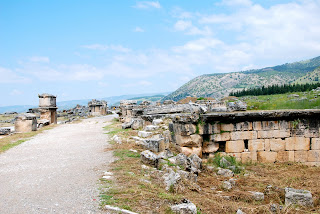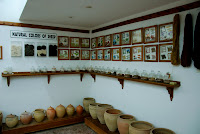I recently returned from a fantastic trip to Turkey with my parents, aunt, and cousin. After arriving at Sirkeci Station, the last stop of the Orient Express, we embarked on a whirlwind tour of Istanbul, the cave cities of Cappadocia, and the ancient cities near Izmir.
Our time in Cappadocia was my favorite, it wasn't very crowded, the weather was nice, and the things we saw were incredible. Cappodocia is located in the center of the country, a few hours away by plane.
Göreme
We stayed in a hotel with rooms built into the rock like a cave. It was a very nice hotel. Though the weather was pleasant during our visit, apparently the summers heat and winter cold can be very extreme. By building homes (or hotels) inside of rocks, as has been done there for centuries, people are able to keep indoor temperatures reasonable without absurd heating/cooling bills.
Rose Valley
Cave churches and once inhabited homes, now high up on the cliffsides, are scattered along the 4 kilometer hike through the valley. Later in the day, we visited the Göreme Open Air Museum, a walk through park with frescoed churches from the 10th, 11th, and 12th centuries.
Rock Castles: Üchişar & Ortisar
When the caves were no longer used for human inhabitation, they were transformed into pigeon homes. The pigeons provided farmers with fertilizer.
 |
| Pigeon Homes |
 |
| Can you guess? This was Pigeon Valley. |
Kaymakli Underground City The Kaymakli Underground City was created by the Hittites and expanded thereafter. The Underground Cities, of which there are 36 in Cappadocia, were not intended for permanent habitation, but were used to escape marauding armies that passed through. They fell into disuse and was forgotten until its rediscovery in the 1900s.
Kaymakli is believed to have been able to sustain between 3,500-5,000 people for an extended period of time. It extends 8 floors down, about 360 feet into the earth. The nature of the rock allowed for kitchen fires to burn without windows, much of the smoke being absorbed by the soft stone.
- Entrances to the underground were scattered throughout the surface city, often in the back of barns or cellars. Several layers of doors, sealable by large stones that could only be rolled from one side provided additional security. Water was brought up by a well and ventilation was provided by several shafts. There were rooms for food storage, religious worship, ill or infirm people, the dead, in addition to sleeping and living rooms.
 |
| Inside the Kaymakli |
 |
Here you can see where tools were used to cut into the rocks.
The depression I'm sitting in was used to store pottery-probably with food. |
Avanos
Avanos was the center of pottery making for the Hittites. The Hittites lived in what is modern day Turkey during the Bronze Age from the 18th to 11th century BC. They recorded information from their daily lives on clay tablets and some of the techniques they developed for pottery making are still used today.
The pitcher with the large hole in the center was used for wine drinking during parties. Men would carry it around by sliding an arm through the hole and tilting it to pour.

 |
| Pasabag, or Monks Valley, contains some of the most famous fairy chimney rocks in the region. Churches are built into the rocks and St. Simeon, it is believed, lived here in seclusion in the 5th century |
 |
| Dervent Rock Formations-can you see the camel on the left? |
Carpet Industry
Despite looking forward to a break from anything to do with carpets or weaving, we visited a carpet weaving co-op in Cappadocia. It is organized by the government and private industry. It was really impressive work they're doing: they preserve traditional skills, provide training, create jobs, make a profit, and educate tourists. The facility is excellent, with all sorts of demonstrations. I would love something like this in Chiprovtsi!
Evil Eyes
The tree below is decorated with nazars, trinkets that are believed to protect against the evil eye. The evil eye curse is attracted to and absorbed by the nazar before it can cause harm. I've seen nazars everywhere during my time in Turkey-on jewelry, airplanes, walls, etc.
I also rode a camel.


















































